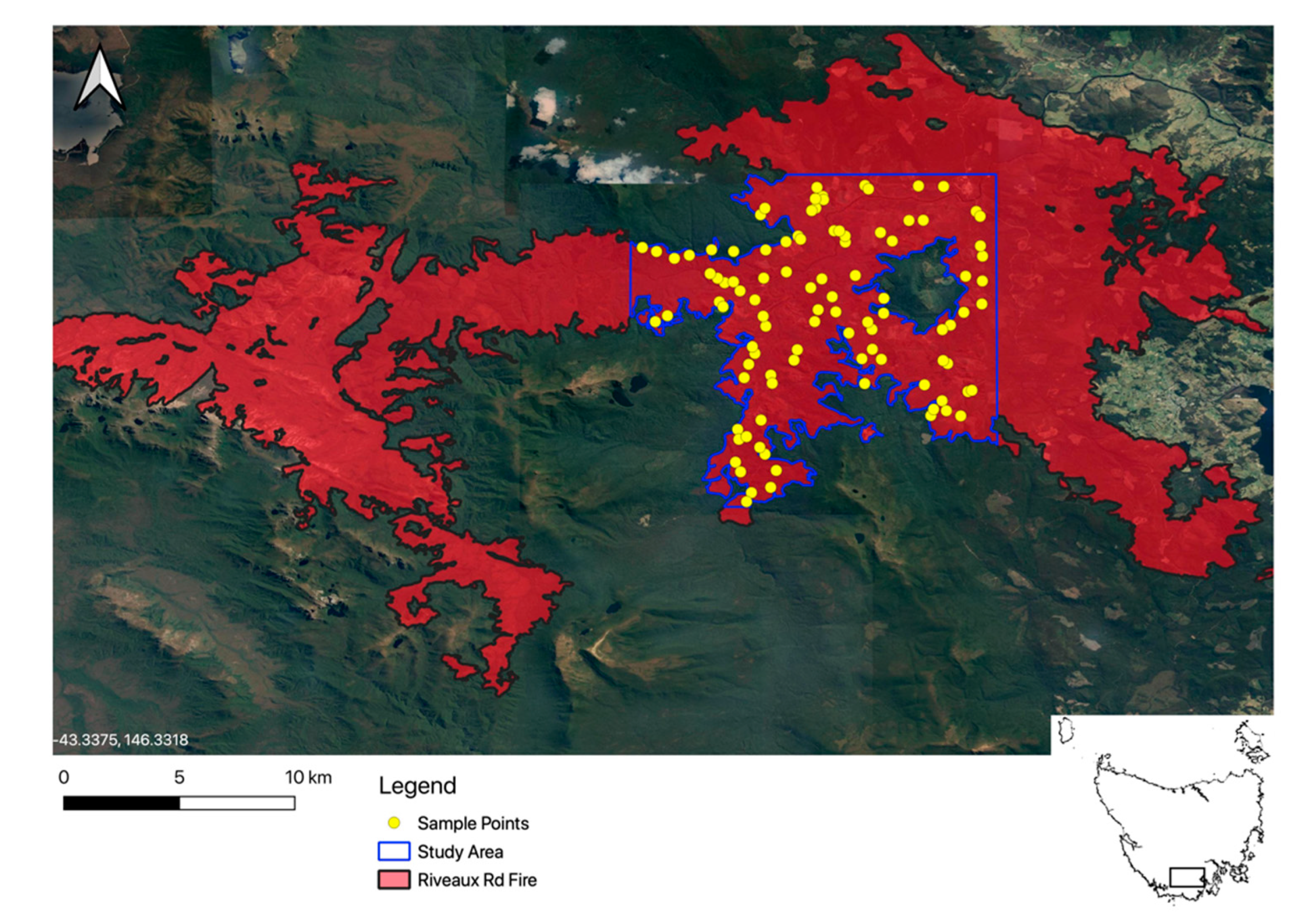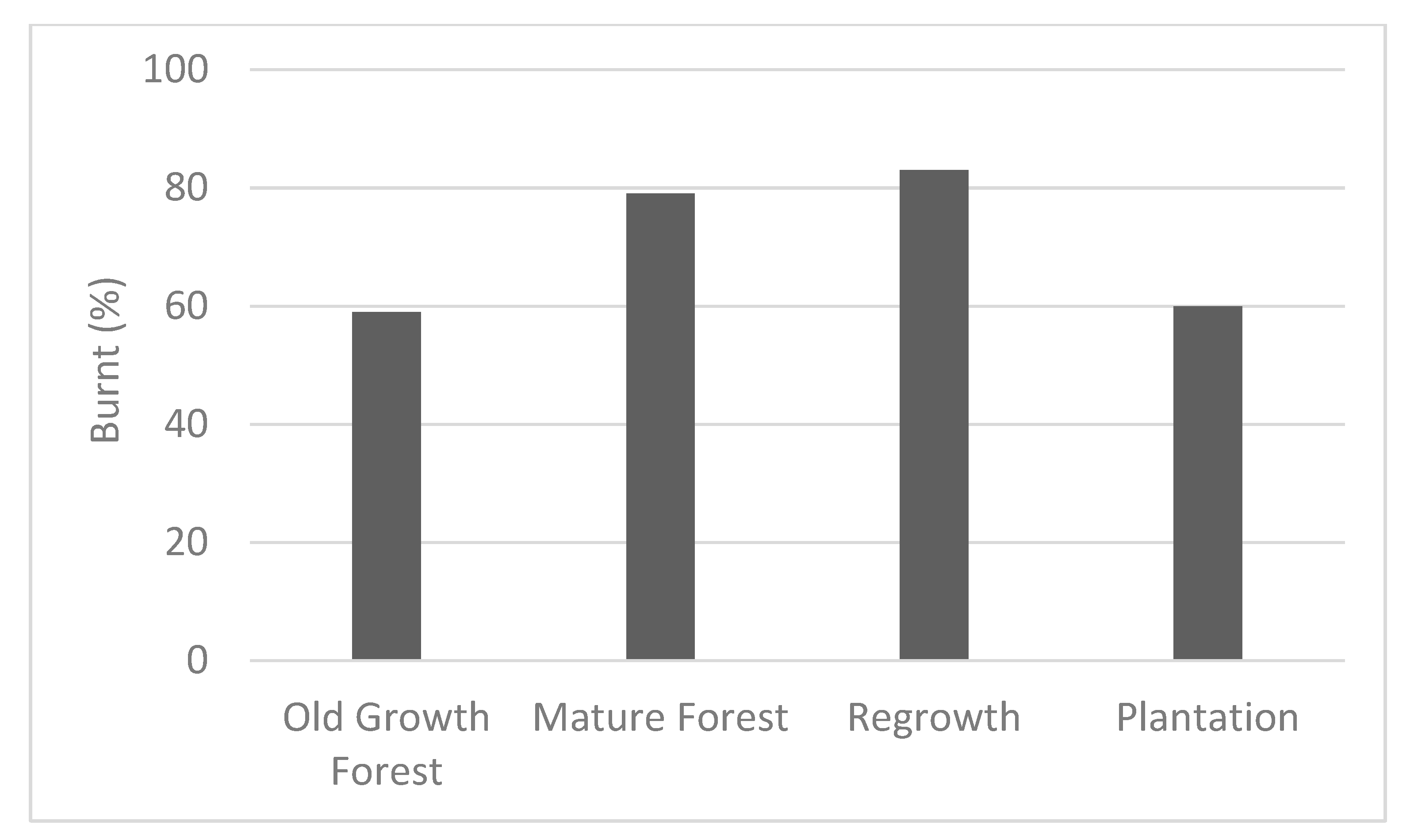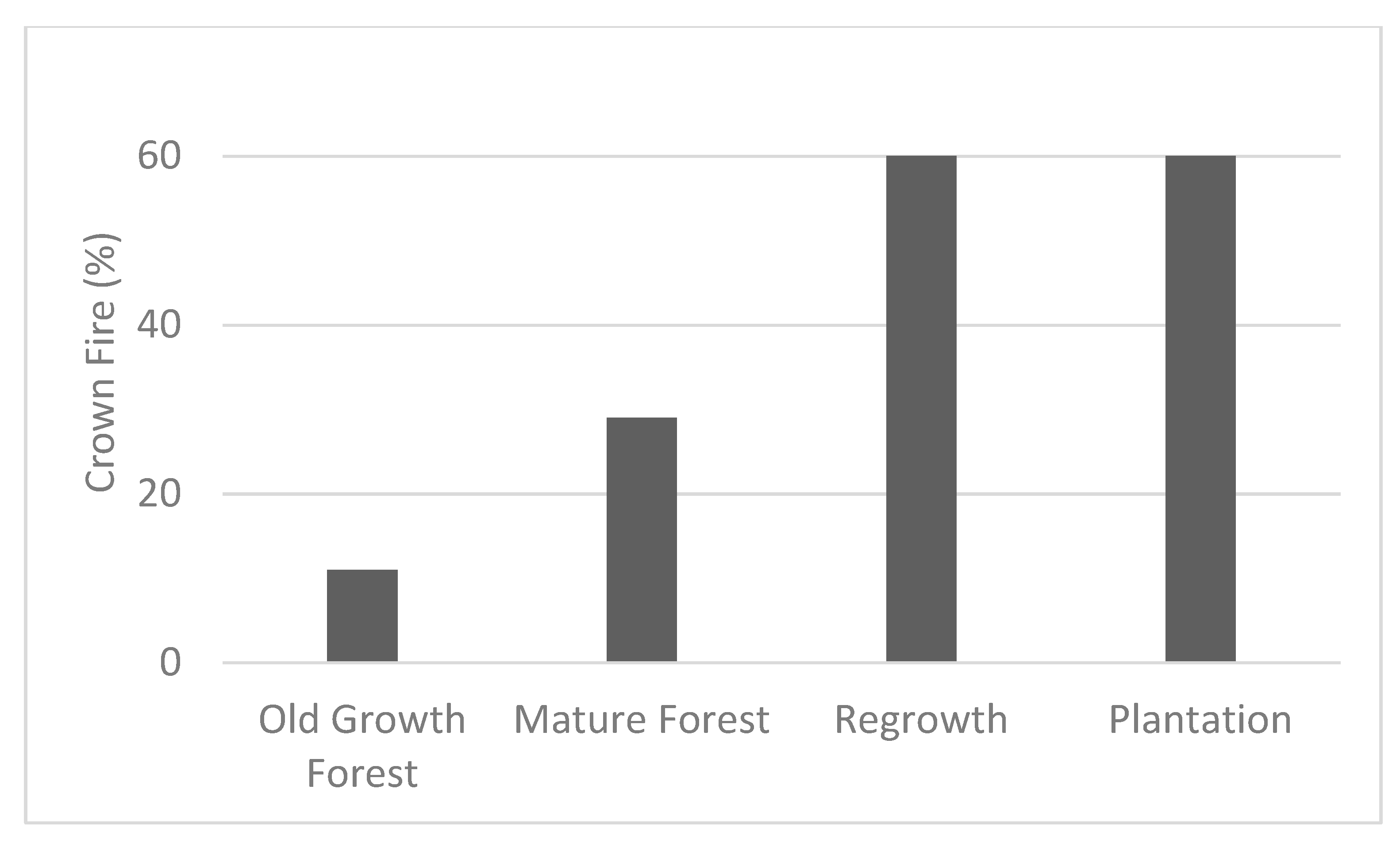RETRACTED: Propensities of Old Growth, Mature and Regrowth Wet Eucalypt Forest, and Eucalyptus nitens Plantation, to Burn During Wildfire and Suffer Fire-Induced Crown Death
Abstract
1. Introduction
2. Materials and Methods
2.1. Study Area
2.2. Study Design
2.3. Statistical Analyses
3. Results
4. Discussion
5. Conclusions
Author Contributions
Funding
Conflicts of Interest
Appendix A
| Figure Type | Latitude | Longitude |
|---|---|---|
| Mature Forest N = 28 | −43.08303 | 146.64068 |
| −43.1454 | 146.6975 | |
| −43.18016 | 146.69161 | |
| −43.07995 | 146.71744 | |
| −43.09978 | 146.73659 | |
| −43.14320117 | 146.7217038 | |
| −43.11016 | 146.76972 | |
| −43.14243 | 146.75797 | |
| −43.11317 | 146.82207 | |
| −43.12675716 | 146.7633651 | |
| −43.0801363 | 146.7491124 | |
| −43.11205417 | 146.6818051 | |
| −43.19338837 | 146.706203 | |
| −43.15118863 | 146.7092791 | |
| −43.09835272 | 146.813395 | |
| −43.10181905 | 146.6846046 | |
| −43.0960364 | 146.7176345 | |
| −43.16487128 | 146.8008163 | |
| −43.12446248 | 146.805289 | |
| −43.12257778 | 146.732741 | |
| −43.05575735 | 146.7370589 | |
| −43.06846053 | 146.7907608 | |
| −43.06377419 | 146.8190625 | |
| −43.15994797 | 146.8146598 | |
| −43.14499515 | 146.803759 | |
| −43.09941536 | 146.6808368 | |
| −43.08424 | 146.67764 | |
| −43.07956 | 146.77419 | |
| Old Growth N = 27 | −43.08515 | 146.64824 |
| −43.12263 | 146.6476 | |
| −43.0655074 | 146.7038219 | |
| −43.08431 | 146.70658 | |
| −43.12503 | 146.70664 | |
| −43.08882475 | 146.6577918 | |
| −43.19767106 | 146.6904315 | |
| −43.17274107 | 146.7948133 | |
| −43.06194675 | 146.7333377 | |
| −43.1395778 | 146.7008108 | |
| −43.1061844 | 146.6928751 | |
| −43.12869 | 146.75099 | |
| −43.05016 | 146.78821 | |
| −43.1146543 | 146.6837872 | |
| −43.17519516 | 146.7040771 | |
| −43.20208056 | 146.7122196 | |
| −43.21392569 | 146.6989478 | |
| −43.04989754 | 146.7596096 | |
| −43.09795 | 146.75448 | |
| −43.13735028 | 146.7635581 | |
| −43.05699434 | 146.7330971 | |
| −43.08764566 | 146.8224413 | |
| −43.07408108 | 146.7430955 | |
| −43.07691053 | 146.7238735 | |
| −43.17294907 | 146.8107889 | |
| −43.08509 | 146.68944 | |
| −43.07502 | 146.7679 | |
| Plantation N = 10 | −43.15255 | 146.69509 |
| −43.18547 | 146.69224 | |
| −43.11973 | 146.70522 | |
| −43.10448 | 146.73063 | |
| −43.11764 | 146.81243 | |
| −43.07688353 | 146.749029 | |
| −43.11737 | 146.74405 | |
| −43.05044 | 146.80162 | |
| −43.1008982 | 146.8223385 | |
| −43.06859812 | 146.7831244 | |
| Regrowth N = 35 | −43.11947 | 146.65409 |
| −43.06204 | 146.70617 | |
| −43.13761358 | 146.7234643 | |
| −43.11815 | 146.76958 | |
| −43.15569 | 146.75947 | |
| −43.08713092 | 146.665777 | |
| −43.12284072 | 146.7610805 | |
| −43.20281548 | 146.693155 | |
| −43.16940257 | 146.7962776 | |
| −43.0633208 | 146.7311239 | |
| −43.13596986 | 146.6994332 | |
| −43.11101999 | 146.7008032 | |
| −43.18401673 | 146.6963299 | |
| −43.21111571 | 146.7092367 | |
| −43.21876749 | 146.696354 | |
| −43.18973554 | 146.7034153 | |
| −43.15551434 | 146.7100481 | |
| −43.05176174 | 146.7614738 | |
| −43.1013635 | 146.6893879 | |
| −43.09937212 | 146.7055105 | |
| −43.10931557 | 146.7421104 | |
| −43.15635164 | 146.7914153 | |
| −43.14272755 | 146.7683749 | |
| −43.12690012 | 146.8009437 | |
| −43.11625033 | 146.7345929 | |
| −43.05748329 | 146.7374861 | |
| −43.05095175 | 146.7339691 | |
| −43.06637026 | 146.8211688 | |
| −43.08214941 | 146.8213097 | |
| −43.15929051 | 146.8167518 | |
| −43.14340951 | 146.8013612 | |
| −43.07417457 | 146.7459314 | |
| −43.07860165 | 146.7252177 | |
| −43.17019969 | 146.8031068 | |
| −43.09698709 | 146.6768909 |
References
- Whittaker, J. Ten years after the Black Saturday fires, what have we learnt from post-fire research? Aust. J. Emerg. Manag. 2019, 34, 32–37. [Google Scholar]
- Bushfires Death Toll Rises to 33 after Body Found in Burnt-Out House near MORUYA. Available online: https://www.theguardian.com/australia-news/2020/jan/24/bushfires-death-toll-rises-to-33-after-body-found-in-burnt-out-house-near-moruya (accessed on 24 January 2020).
- Cochrane, M.A.; Barber, C.P. Climate change, human land use and future fires in the Amazon. Glob. Chang. Biol. 2009, 15, 601–612. [Google Scholar] [CrossRef]
- Mariani, M.; Holz, A.; Veblen, T.; Williamson, G.; Fletcher, M.-S.; Bowman, D. Climate Change Amplifications of Climate-Fire Teleconnections in the Southern Hemisphere. Geophys. Res. Lett. 2018, 45, 5071–5081. [Google Scholar] [CrossRef]
- Halofsky, J.E.; Peterson, D.L.; Harvey, B.J. Changing wildfire, changing forests: The effects of climate change on fire regimes and vegetation in the Pacific Northwest, USA. Fire Ecol. 2020, 16, 4. [Google Scholar] [CrossRef]
- Spies, T.A.; White, E.M.; Kline, J.D.; Fischer, A.P.; Ager, A.; Bailey, J.; Bolte, J.; Koch, J.; Platt, E.; Olsen, C.S.; et al. Examining fire-prone forest landscapes as coupled human and natural systems. Ecol. Soc. 2014, 19, 9. [Google Scholar] [CrossRef]
- Schoennagel, T.; Veblen, T.T.; Romme, W.H. The Interaction of Fire, Fuels, and Climate across Rocky Mountain Forests. BioScience 2004, 54, 661–676. [Google Scholar] [CrossRef]
- Hickey, J.E.; Wilkinson, G.R. The development and current implementation of silvicultural practices in native forests in Tasmania. Aust. For. 1999, 62, 245–254. [Google Scholar] [CrossRef]
- Forestry Tasmania. Lowland Wet Eucalypt Forest; Native Forest Silviculture Technical Bulletin No. 8; Forestry Tasmania: Hobart, Australia, 1998. [Google Scholar]
- Volkova, L.; Aparicio, A.G.W.; Weston, C.J. Fire intensity effects on post-fire fuel recovery in Eucalyptus open forests of south-eastern Australia. Sci. Total Environ. 2019, 670, 328–336. [Google Scholar] [CrossRef]
- Taylor, C.; McCarthy, M.A.; Lindenmayer, D.B. Nonlinear effects of stand age on fire severity. Conserv. Lett. 2014, 7, 355–370. [Google Scholar] [CrossRef]
- Bradstock, R.A. A biogeographic model of fire regimes in Australia: Current and future implications. Glob. Ecol. Biogeogr. 2010, 19, 145–158. [Google Scholar] [CrossRef]
- Bradstock, R.A.; Hammill, K.A.; Collins, L.; Price, O. Effects of weather, fuel and terrain on fire severity in topographically diverse landscapes of south-eastern Australia. Landsc. Ecol. 2010, 25, 607–619. [Google Scholar] [CrossRef]
- Meyn, A.; White, P.S.; Buhk, C.; Jentsch, A. Environmental drivers of large, infrequent wildfires: The emerging conceptual model. Prog. Phys. Geogr. Earth Environ. 2007, 31, 287–312. [Google Scholar] [CrossRef]
- Fox-Hughes, P. A fire danger climatology for Tasmania. Aust. Meteorol. Manag. 2008, 57, 109–120. [Google Scholar]
- Attiwill, P.M.; Adams, M.A. Mega-fires, inquiries and politics in the eucalypt forests of Victoria, south-eastern Australia. For. Ecol. Manag. 2013, 294, 45–53. [Google Scholar] [CrossRef]
- Williamson, G.J.; Prior, L.D.; Jolly, W.M.; Cochrane, M.A.; Murphy, B.P.; Bowman, D.M. Measurement of inter-and intra-annual variability of landscape fire activity at a continental scale: The Australian case. Environ. Res. Lett. 2016, 11, 035003. [Google Scholar] [CrossRef]
- Zylstra, P.J. Flammability dynamics in the Australian Alps. Austral Ecol. 2018, 43, 578–591. [Google Scholar] [CrossRef]
- Cawson, J.G.; Duff, T.J.; Swan, M.H.; Penman, T.D. Wildfire in wet sclerophyll forests: The interplay between disturbances and fuel dynamics. Ecosphere 2018, 9, e02211. [Google Scholar] [CrossRef]
- Mackey, B.; Lindenmayer, D.; Gill, M.; Lindesay, J. Wildlife, Fire & Future Climate: A Forest Ecosystem Analysis; CSIRO Publishing: Victoria, Australia, 2020; p. 30. [Google Scholar]
- Bowman, D.M.; Murphy, B.P.; Neyland, D.L.J.; Williamson, G.J.; Prior, L.D. Abrupt fire regime change may cause landscape-wide loss of mature obligate seeder forests. Glob. Chang. Biol. 2014, 20, 1008–1015. [Google Scholar] [CrossRef]
- Serong, M.; Lill, A. The timing and nature of floristic and structural changes during secondary succession in wet forests. Aust. J. Bot. 2008, 56, 220–231. [Google Scholar] [CrossRef]
- Zylstra, P.; Bradstock, R.A.; Bedward, M.; Penman, T.D.; Doherty, M.D.; Weber, R.O.; Cary, G.J. Biophysical mechanistic modelling quantifies the effects of plant traits on fire severity: Species, not surface fuel loads, determine flame dimensions in eucalypt forests. PLoS ONE 2016, 11, e0160715. [Google Scholar] [CrossRef]
- Lindenmayer, D.B.; Hunter, M.L.; Burton, P.J.; Gibbons, P. Effects of logging on fire regimes in moist forests. Conserv. Lett. 2009, 2, 271–277. [Google Scholar] [CrossRef]
- McColl-Gausden, S.C.; Penman, T.D. Pathways of change: Predicting the effects of fire on flammability. J. Environ. Manag. 2019, 232, 243–253. [Google Scholar] [CrossRef] [PubMed]
- Cawson, J.G.; Duff, T.J.; Tolhurst, K.G.; Baillie, C.C.; Penman, T.D. Fuel moisture in Mountain Ash forests with contrasting fire histories. For. Ecol. Manag. 2017, 400, 568–577. [Google Scholar] [CrossRef]
- Bowman, D.M.; Williamson, G.J.; Prior, L.D.; Murphy, B.P. The relative importance of intrinsic and extrinsic factors in the decline of obligate seeder forests. Glob. Ecol. Biogeogr. 2016, 25, 1166–1172. [Google Scholar] [CrossRef]
- Attiwill, P.M.; Ryan, M.F.; Burrows, N.; Cheney, N.P.; McCaw, L.; Neyland, M.; Read, S. Timber harvesting does not increase fire risk and severity in wet eucalypt forests of southern Australia. Conserv. Lett. 2014, 7, 341–354. [Google Scholar] [CrossRef]
- Keeley, J.E. Fire intensity, fire severity and burn severity: A brief review and suggested usage. Int. J. Wildland Fire 2009, 18, 116–126. [Google Scholar] [CrossRef]
- Hammill, K.A.; Bradstock, R.A. Remote sensing of fire severity in the Blue Mountains: Influence of vegetation type and inferring fire intensity. Int. J. Wildland Fire 2006, 15, 213–226. [Google Scholar] [CrossRef]
- Woodgate, P.W.; Peel, B.D.; Coram, J.E.; Farrell, S.J.; Ritman, K.T.; Lewis, A. Old-growth forest studies in Victoria, Australia Concepts and principles. For. Ecol. Manag. 1996, 85, 79–94. [Google Scholar] [CrossRef]
- Kirkpatrick, J.B.; Peacock, R.J.; Cullen, P.J.; Neyland, M.G. The Wet Eucalypt Forests of Tasmania; Tasmanian Conservation Trust: Hobart, Australia, 1988. [Google Scholar]
- Australasian Fire and Emergency Service Authorities Council. AFAC Independent Operational Review: A Review of the Management of the Tasmanian Fires of December 2018–March 2019. Available online: http://www.fire.tas.gov.au/userfiles/AFAC/AFAC_Review.pdf (accessed on 1 March 2020).
- LIST State Aerial Photo Basemap, Accessed through QGIS. 2019. Available online: https://www.thelist.tas.gov.au/app/content/data/geo-meta-data-record?detailRecordUID=46146ba8-2485-411b-bd06-e89447b7329b (accessed on 30 January 2020).
- Department of Primary Industries, Parks, Water & Environment. TasVeg Live: The Digital Vegetation Map of Tasmania; Tasmanian Government: Hobart, Australia, 2014.
- ESRI Images, Accessed on QGIS. 2019. Available online: https://maps.thelist.tas.gov.au/listmap/app/list/map (accessed on 1 March 2020).
- MODIS Collection 6 NRT Hotspot/Active Fire Detections MCD14ML. Available online: https://earthdata.nasa.gov/firms (accessed on 30 January 2020).
- Hantson, S.; Padilla, M.; Corti, D.; Chuvieco, E. Strengths and weaknesses of MODIS hotspots to characterize global fire occurrence. Remote Sens. Environ. 2013, 131, 152–159. [Google Scholar] [CrossRef]
- Department of State Growth, Tasmanian Government. Tasmania’s Forest Management System: An Overview. 2017. Available online: https://www.stategrowth.tas.gov.au/__data/assets/pdf_file/0018/154620/5_Overview_Tasmania_Forest_Management_System_2017.pdf (accessed on 21 January 2020).
- Clarke, P.J.; Knox, K.J.E.; Bradstock, R.A.; Munoz-Robles, C.; Kumar, L. Vegetation, terrain and fire history shape the impact of extreme weather on fire severity and ecosystem response. J. Veg. Sci. 2014, 25, 1033–1044. [Google Scholar] [CrossRef]
- Price, O.F.; Bradstock, R.A. The efficacy of fuel treatment in mitigating property loss during wildfires: Insights from analysis of the severity of the catastrophic fires in 2009 in Victoria, Australia. J. Environ. Manag. 2012, 113, 146–157. [Google Scholar] [CrossRef] [PubMed]
- Ashton, D.H. The development of even-aged stands of Eucalyptus regnans F. Muell. in central Victoria. Aust. J. Bot. 1976, 24, 397–414. [Google Scholar] [CrossRef]
- Florence, R.G. The ecological basis of forest fire management in New South Wales. In The Burning Continent: Forest Ecosystems and Fire Management in Australia; Attiwill, P.M., Florence, R.G., Hurditch, W.E., Eds.; Institute of Public Affairs: Jolimont, Australia, 1994. [Google Scholar]
- Lindenmayer, D.B.; Hobbs, R.J.; Likens, G.E.; Krebs, C.J.; Banks, S.C. Newly discovered landscape traps produce regime shifts in wet forests. Proc. Natl. Acad. Sci. USA 2011, 108, 15887–15891. [Google Scholar] [CrossRef] [PubMed]
- Jackson, W.D. Fire, air, water and earth—An elemental ecology of Tasmania. Proc. Ecol. Soc. Australia 1968, 3, 9–16. [Google Scholar]
- McCaw, L. Understanding the level of fire hazard in a blue gum plantation. Aust. For. Grow. 2003, 25, 18–19. [Google Scholar]
- McCaw, L.; Smith, B. Fire Behaviour in a 6 Year Old Eucalyptus Globulus Plantation during Conditions of Extreme Fire Danger—A Case Study from South-Western Australia; Science Division, Department of Conservation and Land Management: Manjimup Australia, 2005.
- Ndalila, M.N.; Williamson, G.J.; Bowman, D.M. Geographic patterns of fire severity following an extreme eucalyptus forest fire in southern Australia: 2013 Forcett-Dunalley fire. Fire 2018, 1, 40. [Google Scholar] [CrossRef]
- Cruz, M.G.; Sullivan, A.L.; Gould, J.S.; Sims, N.C.; Bannister, A.J.; Hollis, J.J.; Hurley, R.J. Anatomy of a catastrophic wildfire: The Black Saturday Kilmore East fire in Victoria, Australia. For. Ecol. Manag. 2012, 284, 269–285. [Google Scholar] [CrossRef]
- Keith, H.; Mackey, B.G.; Lindenmayer, D.B. Re-evaluation of forest biomass carbon stocks and lessons from the world's most carbon-dense forests. Proc. Natl. Acad. Sci. USA 2009, 106, 11635–11640. [Google Scholar] [CrossRef]
- Sillett, S.C.; Van Pelt, R.; Kramer, R.D.; Carroll, A.L.; Koch, G.W. Biomass and growth potential of Eucalyptus regnans up to 100 m tall. For. Ecol. Manag. 2015, 348, 78–91. [Google Scholar] [CrossRef]
- Dean, C.; Kirkpatrick, J.B.; Friedland, A. Conventional intensive logging promotes loss of organic carbon from the mineral soil. Glob. Chang. Biol. 2017, 23, 1. [Google Scholar] [CrossRef]



| Old Growth | Mature | Regrowth | Plantation | P | |
|---|---|---|---|---|---|
| Unburned (%) | 41 | 21 | 17 | 40 | |
| Understorey fire (%) | 48 | 50 | 22 | 0 | |
| Crown fire (%) | 11 | 29 | 60 | 60 | |
| 0.001 (C) | |||||
| Valley (%) | 22 | 32 | 29 | 50 | |
| Lower slope (%) | 56 | 46 | 54 | 40 | |
| Upper slope (%) | 22 | 21 | 17 | 10 | |
| 0.783 (C) | |||||
| Elevation (m) | 233 | 187 | 197 | 150 | 0.185 |
| Slope (%) | 21 | 17 | 24 | 16 | 0.822 |
| Aspect (°) | 128 | 144 | 137 | 113 | 0.922 |
| Average maximum potential FFDI | 20.32 | 21.13 | 24.54 | 19.22 | 0.17 |
| Mean potential FFDI | 11.07 | 11.05 | 12.15 | 12.94 | 0.51 |
| Old Growth | Mature | Regrowth | Plantation | P | |
|---|---|---|---|---|---|
| Old growth vs. mature (n = 10) | |||||
| Burned | 0 | 60 | na | na | 0.038 |
| Crown fire | 0 | 0 | na | na | 1.000 |
| Old growth vs. regrowth (n = 38) | |||||
| Burned | 68 | na | 79 | na | 0.461 |
| Crown | 11 | na | 53 | na | 0.005 |
| Mature and old growth vs. plantation (n = 20) | |||||
| Burned | 100 | na | 60 | 0.025 | |
| Crown | 40 | Na | 60 | 0.371 | |
| Mature vs. regrowth (n = 32) | |||||
| Burned | na | 75 | 88 | na | 0.365 |
| Crown | Na | 31 | 69 | na | 0.034 |
© 2020 by the authors. Licensee MDPI, Basel, Switzerland. This article is an open access article distributed under the terms and conditions of the Creative Commons Attribution (CC BY) license (http://creativecommons.org/licenses/by/4.0/).
Share and Cite
Winoto-Lewin, S.; Sanger, J.C.; Kirkpatrick, J.B. RETRACTED: Propensities of Old Growth, Mature and Regrowth Wet Eucalypt Forest, and Eucalyptus nitens Plantation, to Burn During Wildfire and Suffer Fire-Induced Crown Death. Fire 2020, 3, 13. https://doi.org/10.3390/fire3020013
Winoto-Lewin S, Sanger JC, Kirkpatrick JB. RETRACTED: Propensities of Old Growth, Mature and Regrowth Wet Eucalypt Forest, and Eucalyptus nitens Plantation, to Burn During Wildfire and Suffer Fire-Induced Crown Death. Fire. 2020; 3(2):13. https://doi.org/10.3390/fire3020013
Chicago/Turabian StyleWinoto-Lewin, Suyanti, Jennifer C. Sanger, and James B. Kirkpatrick. 2020. "RETRACTED: Propensities of Old Growth, Mature and Regrowth Wet Eucalypt Forest, and Eucalyptus nitens Plantation, to Burn During Wildfire and Suffer Fire-Induced Crown Death" Fire 3, no. 2: 13. https://doi.org/10.3390/fire3020013
APA StyleWinoto-Lewin, S., Sanger, J. C., & Kirkpatrick, J. B. (2020). RETRACTED: Propensities of Old Growth, Mature and Regrowth Wet Eucalypt Forest, and Eucalyptus nitens Plantation, to Burn During Wildfire and Suffer Fire-Induced Crown Death. Fire, 3(2), 13. https://doi.org/10.3390/fire3020013





